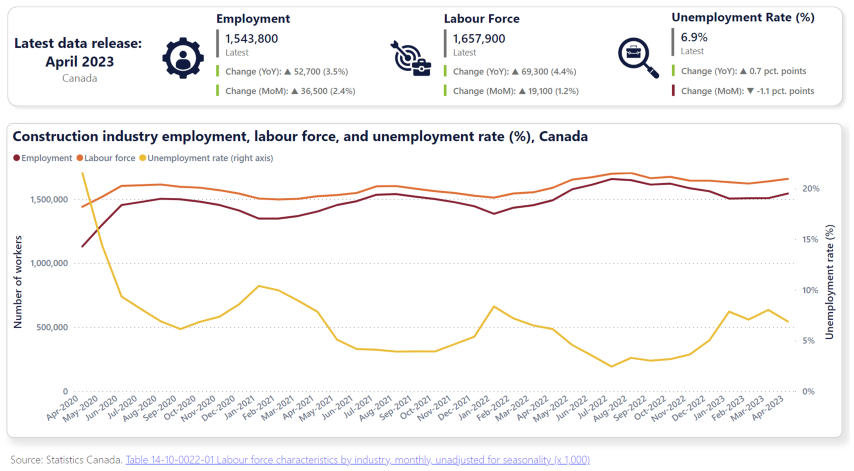The latest Labour Force Survey (LFS) data published by Statistics Canada shows another month of strong employment growth. The April report finds that overall, all-industry employment rose by 41,000 workers (+0.2%) on a seasonally adjusted basis.
Employment increased by 18,000 (+0.3%) among core-aged men (25 to 54 years old) and by 16,000 (+0.7%) among men aged 55 and older. It held steady among core-aged and older women. Four industries reported growth led by wholesale and retail trade (+24,000; +0.8%). Construction, meanwhile, increased by 7,000 workers (+0.4%) – also on a seasonally adjusted basis.
Employment changes were greatest in Ontario (+33,000; +0.4%), Prince Edward Island (+2,200; +2.5%), and Manitoba (-4,000; -0.6%). There was little change in the other provinces.
The national unemployment rate remained unchanged at 5%.
Data for the survey were collected during the week of April 9 to 15.
Construction’s labour force outgrows employment, year over year
On a seasonally unadjusted basis, construction employment increased by 36,200 (+2.4%) between March and April – a sign that the industry is emerging from its traditional seasonal slowdown period. Growth in the labour force, however, failed to keep pace. The labour force grew by 19,000 (+1.2%) for the month. As a result, the industry’s unemployment rate contracted from 8% to 6.9%.

Compared with April 2022, the trends in employment and labour force growth are reversed. Over the past 12 months, employment across the industry grew by 52,700 (+3.5%) while the labour force increased by 69,400 (+4.4%). Unemployment rates, as a result, increased from 6.1% in April 2022 to 6.9% in April 2023.
With some industries experiencing declining employment opportunities, construction is well positioned to attract additional workers. Employment demands continued to grow in April versus the same month last year. This is evident from strong labour force growth, especially among the core working-age population (i.e., those aged 25-54 years).
Significant job opportunities in the construction industry are likely accelerating labour force growth, especially for women, as sectors such as wholesale and retail trade and educational services have slowed. Year-over-year, the labour force for women in their prime working age (i.e., 25-54 years old) increased by 16%, compared to declines in wholesale and retail trades (-5%) and educational services (-6%).
Across the provinces, Ontario reported the largest absolute month-over-month gain in employment, adding 18,600 (+3.3%). Alberta (9,200; +4.2%) and Quebec (8,900; +3.1%) followed. Three provinces reported month-over-month employment contractions: British Columbia (-1,800; -0.7%), Nova Scotia (-500; -1.4%), and Prince Edward Island (-100; -1.5%). Labour force growth followed similar patterns, with absolute growth greatest in Quebec (9,100; +2.9%) and Ontario (7,400; 1.2%), and declines largest in British Columbia (-3,300; -1.3%) and Nova Scotia (-400; -1.0%).
On an annual basis, employment growth was highest in Quebec (26,600; 9.8%), which accounted for more than half of the total employment growth in the country in the past year. British Columbia (15,900; +6.9%) and Ontario (9,400; +1.6%) followed. Only three provinces showed employment contractions compared with the year previous: Saskatchewan (-5,000; -10.9%), Nova Scotia (-4,400; -10.9%), and New Brunswick (-300; -1.1%). Labour force changes again followed similar trends, with growth greatest in Quebec (33,500; +11.6%) and British Columbia (19,300; 8.2%). Labour force declines were pronounced in Saskatchewan (-6,200; -12.3%) and Nova Scotia (-3,300; -7.5%).
Unemployment rates across the provinces ranged from a high of 26.8% in Newfoundland and Labrador to a low of 4.1% in British Columbia. Outside Atlantic Canada, where unemployment rates exceeded 11%, the remaining provinces reported unemployment rates of between 7.7% (Saskatchewan) and 6.2% (Ontario).


Construction Key Indicators
